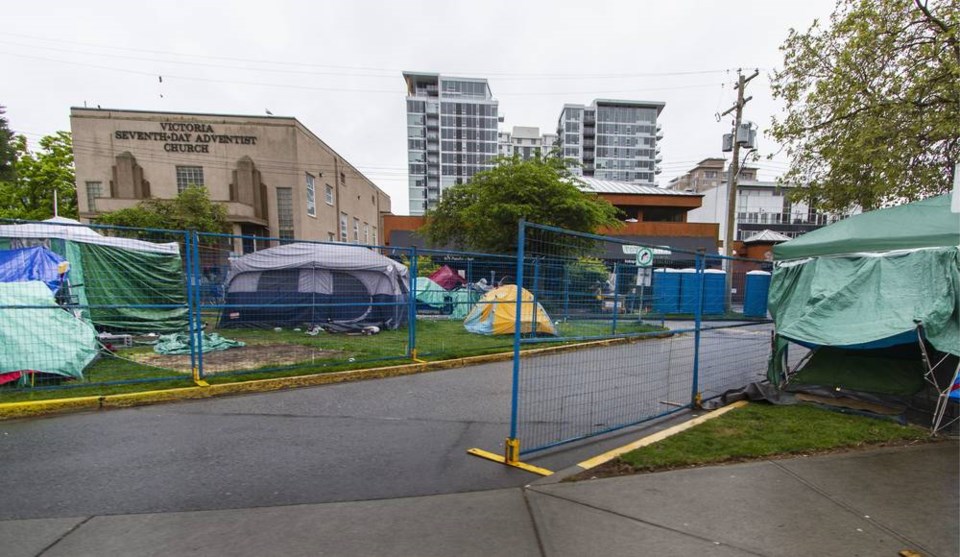By the day it becomes ever more clear that our governments, federal, provincial and municipal, have no idea how to deal with homelessness.
City council in Victoria recently gave a demonstration of that when, just two days after ordering homeless campers to vacate Centennial Square, council reversed itself and allowed them to return.
Part of the problem is that our political leaders, at all levels, are focused more on the symptoms of homelessness, than the causes. To a degree, that’s understandable.
We have more than 1,500 people in Greater Victoria alone who cannot find or afford a proper place to live. Nationwide, the figure is around 235,000.
No-one should have to eke out such an existence.
At the same time there is the impact on the broader community: Parks turned into tent cities, discarded needles strewn around, violence and chop shops in open view.
So yes, there are plenty of symptoms to rivet our attention. But the reason they exist is that the root causes of homelessness are left unattended.
So what are those root causes? What follows is a brief snapshot of the homeless population in Greater Victoria just as the COVID-19 outbreak was beginning. From this snapshot, the causes can be traced.
According to a survey in March, 1,523 homeless people lived in the capital region, of whom 70 per cent were aged 25 to 54. That in itself is telling. We’re dealing primarily with an adult population.
And more than that, we’re dealing almost exclusively with single adults.
There are very few mothers with children. We’ll return to that in a moment.
Moving on, 61 per cent of the homeless population have been without a permanent roof over their head for a year or longer.
That too is telling. Homelessness is not a passing phase. For many, it has elements of near permanence. This suggests purely temporary stop-gaps will not work.
And 30 per cent of homeless people began their lives in foster care — a genuinely troubling fact.
Not surprisingly, two-thirds report a history of substance abuse, while more than half suffer mental health issues. And 40 per cent have a physical disability.
So much for the snapshot. What does it tell us?
When one in three homeless people begin their lives in foster care (rising to 55 per cent among Indigenous people), this is clearly the place to start.
Kids from broken homes are always going to face greater than normal challenges. Not all of this can be laid at government’s door.
But if we’re looking for root causes to attack, repairing the transition from foster care to independent living should be the first priority.
Next, it’s shameful that fully 40 per cent of our homeless population have physical disabilities. This controverts the image some have of healthy young people who don’t want a job.
More to the point, it calls for a re-examination of social assistance rates for this group.
A single person with a disability in B.C. receives $13,096 per year in social assistance — not nearly enough to get by on.
These people are not living on the street out of choice. They lack the physical well-being to gain and hold employment. This too demands attention.
Then there is the fact that substance abuse and mental health issues play such a large role. There are divided opinions as to causality here. Does substance abuse lead to homelessness, or is it the other way round?
What we can say is that the province’s mental health services, already stretched to breaking point, badly need reinforcing. There will be no cure for homelessness so long as it remains the fall-back option for patients suffering mental disorders.
After dealing with the more readily addressed root causes, however, more intractable difficulties arise. It’s no accident there are hardly any single mothers with children among our homeless population.
In B.C., a single mother with two children aged four and 10 qualifies for $31,261 a year in social assistance, consisting of a B.C. Basic Welfare allowance of $14,227 and federal/provincial child benefits totalling $17,034.
While this is barely enough to get by on, it does appear sufficient, if only just.
But now, consider what single adults receive, remembering they are 70 per cent of the homeless population.
In B.C., a single person considered employable gets social assistance/welfare worth $8,124 a year, or $677 per month. Clearly this is nothing like enough to pay living expenses. Rents alone are well above that in the capital region.
The intent in keeping this rate low is to encourage single employables to find a job. How many of this group are genuinely employable is a good question. Many have marginal skills.
But what should be done? By all means provide more and better job training.
By all means cut off clearly employable people who can’t be bothered finding a job. Though we already do that.
But then what? Do we hike the monthly allowance?
B.C.’s rates are generally comparable to those of the other provinces. If we raise them, we open our doors to an influx from elsewhere in Canada.
Yet this is one of the main reasons homeless people in Greater Victoria (and elsewhere) cannot afford a roof over their head.
Where then does this leave us? Clearly we need a genuinely national approach. No one province, and no one city, can go it alone.
We did once have a national program — the Canada Assistance Plan — by which the federal government co-funded eligible social assistance benefits.
But the plan was killed during the cost-cutting period of the late 1990s, and the funds were rolled into federal transfer payments.
That left the country with 10 plans, not one.
After the COVID outbreak tapers off, addressing homelessness must surely become one of our country’s first priorities.
We’ve suggested some solutions here. Others will add theirs.
But more than anything, a concerted effort will be required across all levels of government before this affront to human dignity is removed.



